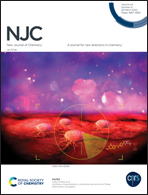A computational study on boron dipyromethene ancillary acceptor-based dyes for dye-sensitized solar cells†
Abstract
A series of (D-π)2–An–A based organic dyes containing a boron dipyrromethene (BODIPY) moiety as an ancillary acceptor (An) derivative were chosen, and the effect of donor moieties (diarylamine, carbazole, azepine, and dibenzazepine) was investigated to understand their photophysical and photoelectrochemical properties by employing density functional theory (DFT) and time-dependent DFT. It is experimentally proved that BODIPY enhances light-harvesting in the red and near IR regions of visible light. Electron density distribution analysis was performed for all the dyes to confirm the intramolecular charge transfer, envisioned from the simulated absorption spectra of the dyes. Carbazole donor-based dyes exhibited the lowest reorganization energy. A dye attached to the TiO2(1 0 1) surface was modeled to estimate the adsorption energy of the dyes. The density of states analysis revealed that the absence of defect states in the bandgap of TiO2 facilitates smooth electron transfer from the excited state of the dye to the conduction band of TiO2. Considering the lowest unoccupied molecular orbital (LUMO) energy level of the dyes and the conduction band energy level of TiO2, it is understood that all the dyes studied in this report are capable of electron injection upon photoexcitation. Considering the driving force for dye regeneration and the magnitude of reorganization energy, a carbazole donor-based dye (D2) would be the best performing dye in DSSCs. Previously, the power conversion efficiencies of the dyes have been reported, and the carbazole donor-based dye (D2) exhibited the highest efficiency among all the dyes. Our computational investigations are in good agreement with the experimental results.



 Please wait while we load your content...
Please wait while we load your content...